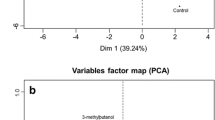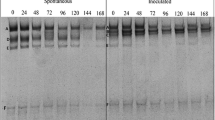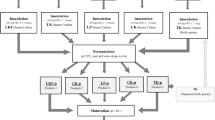Abstract
Enterococcus faecium is frequently isolated from fermented food; in particular, they positively contribute to the aroma compound generation in traditional cheese. Citrate fermentation is a desirable property in these bacteria, but this feature is not uniformly distributed among E. faecium strains. In the present study, three selected E. faecium strains, IQ110 (cit−), GM70 (cit+ type I), and Com12 (cit+ type II), were analyzed in their production of aroma compounds in milk. End products and volatile organic compounds (VOCs) were determined by solid-phase micro-extraction combined with gas chromatography mass spectrometry (SPME-GC-MS). Principal component analysis (PCA) of aroma compound profiles revealed a different VOC composition for the three strains. In addition, resting cell experiments of E. faecium performed in the presence of leucine, citrate, or pyruvate as aroma compound precursors allowed us to determine metabolic differences between the studied strains. GM70 (cit+ type I) showed an active citrate metabolism, with increased levels of diacetyl and acetoin generation relative to Com12 or to citrate defective IQ110 strains. In addition, in the experimental conditions tested, a defective citrate-fermenting phenotype for the Com12 strain was found, while its leucine degradation and pyruvate metabolism were conserved. In conclusion, rational selection of E. faecium strains could be performed based on genotypic and phenotypic analyses. This would result in a performing strain, such as GM70, that could positively contribute to flavor, with typical notes of diacetyl, acetoin, 3-methyl butanal, and 3-methyl butanol in an adjuvant culture.




Similar content being viewed by others
References
Afzal MI, Delaunay S, Paris C, Borges F, Revol-Junelles AM, Cailliez-Grimal C (2012) Identification of metabolic pathways involved in the biosynthesis of flavor compound 3-methylbutanal from leucine catabolism by Carnobacterium maltaromaticum LMA 28. Int J Food Microbiol 157(3):332–339. https://doi.org/10.1016/j.ijfoodmicro.2012.05.010
Arias CA, Murray BE (2012) The rise of the Enterococcus: beyond vancomycin resistance. Nat Rev Microbiol 10(4):266–278. https://doi.org/10.1038/nrmicro2761
Barbosa J, Borges S, Teixeira P (2014) Selection of potential probiotic Enterococcus faecium isolated from Portuguese fermented food. Int J Food Microbiol 191:144–148. https://doi.org/10.1016/j.ijfoodmicro.2014.09.009
Blancato VS, Magni C, Lolkema JS (2006) Functional characterization and Me2+ ion specificity of a Ca2+-citrate transporter from Enterococcus faecalis. FEBS J 273(22):5121–5130. https://doi.org/10.1111/j.1742-4658.2006.05509.x
Blancato VS, Repizo GD, Suarez CA, Magni C (2008) Transcriptional regulation of the citrate gene cluster of Enterococcus faecalis involves the GntR family transcriptional activator CitO. J Bacteriol 190(22):7419–7430. https://doi.org/10.1128/JB.01704-07
Blancato VS, Pagliai FA, Magni C, Gonzalez CF, Lorca GL (2016) Functional analysis of the citrate activator CitO from Enterococcus faecalis implicates a divalent metal in ligand binding. Front Microbiol 7:101. https://doi.org/10.3389/fmicb.2016.00101
Broadbent JR, Gummalla S, Hughes JE, Johnson ME, Rankin SA, Drake MA (2004) Overexpression of Lactobacillus casei D-hydroxyisocaproic acid dehydrogenase in Cheddar cheese. Appl Environ Microbiol 70(8):4814–4820. https://doi.org/10.1128/AEM.70.8.4814-4820.2004
Chammas GI, Saliba R, Corrieu G, Beal C (2006) Characterisation of lactic acid bacteria isolated from fermented milk “laban”. Int J Food Microbiol 110(1):52–61. https://doi.org/10.1016/j.ijfoodmicro.2006.01.043
Conrad FD, Owen CM, Patterson J (2004) Solid phase microextraction (SPME) combined with gas-chromatography and olfactometry-mass spectrometry for characterization of cheese aroma compounds. Lebensm Wiss Technol 37:139–154
Curioni PMG, Bosset JO (2002) Key odorants in various cheese types as determined by gas chromatography-olfactometry. Int Dairy J 12(12):959–984
de Cadinanos LP, Garcia-Cayuela T, Yvon M, Martinez-Cuesta MC, Pelaez C, Requena T (2013) Inactivation of the panE gene in Lactococcus lactis enhances formation of cheese aroma compounds. Appl Environ Microbiol 79(11):3503–3506. https://doi.org/10.1128/AEM.00279-13
Di Rienzo JA, Casanoves F, Balzarini MG, Gonzalez L, Tablada M, Robledo CW (2008) InfoStat, versión 2008. FCA, Universidad Nacional de Córdoba, Córdoba
Dudley E, Steele J (2001) Lactococcus lactis LM0230 contains a single aminotransferase involved in aspartate biosynthesis, which is essential for growth in milk. Microbiology 147(Pt 1):215–224. https://doi.org/10.1099/00221287-147-1-215
Espariz M, Repizo G, Blancato V, Mortera P, Alarcon S, Magni C (2011) Identification of malic and soluble oxaloacetate decarboxylase enzymes in Enterococcus faecalis. FEBS J 278(12):2140–2151. https://doi.org/10.1111/j.1742-4658.2011.08131.x
Espariz M, Zuljan FA, Esteban L, Magni C (2016) Taxonomic identity resolution of highly phylogenetically related strains and selection of phylogenetic markers by using genome-scale methods: the Bacillus pumilus group case. PLoS One 11(9):e0163098. https://doi.org/10.1371/journal.pone.0163098
Foulquie Moreno MR, Sarantinopoulos P, Tsakalidou E, De Vuyst L (2006) The role and application of enterococci in food and health. Int J Food Microbiol 106(1):1–24. https://doi.org/10.1016/j.ijfoodmicro.2005.06.026
Franz CM, Huch M, Abriouel H, Holzapfel W, Galvez A (2011) Enterococci as probiotics and their implications in food safety. Int J Food Microbiol 151(2):125–140. https://doi.org/10.1016/j.ijfoodmicro.2011.08.014
Gao H, Jiang X, Pogliano K, Aronson AI (2002) The E1β and E2 subunits of the Bacillus subtilis pyruvate dehydrogenase complex are involved in regulation of sporulation. J Bacteriol 184(10):2780–2788
Giraffa G (2003) Functionality of enterococci in dairy products. Int J Food Microbiol 88(2–3):215–222
Hanchi H, Mottawea W, Sebei K, Hammami R (2018) The genus Enterococcus: between probiotic potential and safety concerns—an update. Front Microbiol 9:1791. https://doi.org/10.3389/fmicb.2018.01791
Hazards EPanel oB, Ricci A, Allende A, Bolton D, Chemaly M, Davies R, Girones R, Herman L, Koutsoumanis K, Lindqvist R, Nørrung B, Robertson L, Ru G, Sanaa M, Simmons M, Skandamis P, Snary E, Speybroeck N, Ter Kuile B, Threlfall J, Wahlström H, Cocconcelli PS, Klein G, Prieto Maradona M, Querol A, Peixe L, Suarez JE, Sundh I, Vlak JM, Aguilera-Gómez M, Barizzone F, Brozzi R, Correia S, Heng L, Istace F, Lythgo C, Fernández Escámez PS (2017) Scientific opinion on the update of the list of QPS-recommended biological agents intentionally added to food or feed as notified to EFSA. EFSA J 15(3):e04664. https://doi.org/10.2903/j.efsa.2017.4664
Kieronczyk A, Skeie S, Langsrud T, Le Bars D, Yvon M (2004) The nature of aroma compounds produced in a cheese model by glutamate dehydrogenase positive Lactobacillus INF15D depends on its relative aminotransferase activities towards the different amino acids. Int Dairy J 14(3):227–235. https://doi.org/10.1016/j.idairyj.2003.07.001
Kim MK, Drake SL, Drake MA (2011) Evaluation of key flavor compounds in reduced- and full-fat Cheddar cheeses using sensory studies on model systems. J Sens Stud 26(4):278–290. https://doi.org/10.1111/j.1745-459X.2011.00343.x
Lapujade P, Cocaign-Bousquet M, Loubiere P (1998) Glutamate biosynthesis in Lactococcus lactis subsp. lactis NCDO 2118. Appl Environ Microbiol 64(7):2485–2489
Lebreton F, Willems RJL, Gilmore MS (2014) Enterococcus diversity, origins in nature, and gut colonization. In: Gilmore MS, Clewell DB, Ike Y, Shankar N (eds) Enterococci: from commensals to leading causes of drug resistant infection. Boston
Magni C, de Mendoza D, Konings WN, Lolkema JS (1999) Mechanism of citrate metabolism in Lactococcus lactis: resistance against lactate toxicity at low pH. J Bacteriol 181(5):1451–1457
Marilley L, Casey MG (2004) Flavours of cheese products: metabolic pathways, analytical tools and identification of producing strains. Int J Food Microbiol 90(2):139–159
Martin MG, Sender PD, Peiru S, de Mendoza D, Magni C (2004) Acid-inducible transcription of the operon encoding the citrate lyase complex of Lactococcus lactis biovar diacetylactis CRL264. J Bacteriol 186(17):5649–5660. https://doi.org/10.1128/JB.186.17.5649-5660.2004
Martin MG, Magni C, de Mendoza D, Lopez P (2005) CitI, a transcription factor involved in regulation of citrate metabolism in lactic acid bacteria. J Bacteriol 187(15):5146–5155. https://doi.org/10.1128/JB.187.15.5146-5155.2005
Martino GP, Quintana IM, Espariz M, Blancato VS, Gallina Nizo G, Esteban L, Magni C (2016a) Draft genome sequences of four Enterococcus faecium strains isolated from Argentine cheese. Genome Announ 4(1). https://doi.org/10.1128/genomeA.01576-15
Martino GP, Quintana IM, Espariz M, Blancato VS, Magni C (2016b) Aroma compounds generation in citrate metabolism of Enterococcus faecium: genetic characterization of type I citrate gene cluster. Int J Food Microbiol 218:27–37. https://doi.org/10.1016/j.ijfoodmicro.2015.11.004
Martino GP, Espariz M, Gallina Nizo G, Esteban L, Blancato VS, Magni C (2018) Safety assessment and functional properties of four enterococci strains isolated from regional Argentinean cheese. Int J Food Microbiol 277:1–9. https://doi.org/10.1016/j.ijfoodmicro.2018.04.012
Mortera P, Pudlik A, Magni C, Alarcon S, Lolkema JS (2013) Ca2+-citrate uptake and metabolism in Lactobacillus casei ATCC 334. Appl Environ Microbiol 79(15):4603–4612. https://doi.org/10.1128/AEM.00925-13
Ogier JC, Serror P (2008) Safety assessment of dairy microorganisms: the Enterococcus genus. Int J Food Microbiol 126(3):291–301. https://doi.org/10.1016/j.ijfoodmicro.2007.08.017
Palmer KL, Gilmore MS (2010) Multidrug-resistant enterococci lack CRISPR-cas. MBio 1(4). https://doi.org/10.1128/mBio.00227-10
Palmer KL, Carniol K, Manson JM, Heiman D, Shea T, Young S, Zeng Q, Gevers D, Feldgarden M, Birren B, Gilmore MS (2010) High-quality draft genome sequences of 28 Enterococcus sp. isolates. J Bacteriol 192(9):2469–2470. https://doi.org/10.1128/JB.00153-10
Pudlik AM, Lolkema JS (2012) Rerouting citrate metabolism in Lactococcus lactis to citrate-driven transamination. Appl Environ Microbiol 78(18):6665–6673. https://doi.org/10.1128/AEM.01811-12
Repizo GD, Mortera P, Magni C (2011) Disruption of the alsSD operon of Enterococcus faecalis impairs growth on pyruvate at low pH. Microbiology 157(Pt 9):2708–2719. https://doi.org/10.1099/mic.0.047662-0
Repizo GD, Blancato VS, Mortera P, Lolkema JS, Magni C (2013) Biochemical and genetic characterization of the Enterococcus faecalis oxaloacetate decarboxylase complex. Appl Environ Microbiol 79(9):2882–2890. https://doi.org/10.1128/AEM.03980-12
Rijnen L, Bonneau S, Yvon M (1999) Genetic characterization of the major lactococcal aromatic aminotransferase and its involvement in conversion of amino acids to aroma compounds. Appl Environ Microbiol 65(11):4873–4880
Shmuel Y (2003) Dictionary of food compounds with CD-ROM. Additives, flavors, and ingredients. Chapman and Hall/CRC, New York
Silbersack J, Jurgen B, Hecker M, Schneidinger B, Schmuck R, Schweder T (2006) An acetoin-regulated expression system of Bacillus subtilis. Appl Microbiol Biotechnol 73(4):895–903. https://doi.org/10.1007/s00253-006-0549-5
Smit BA, van Hylckama Vlieg JE, Engels WJ, Meijer L, Wouters JT, Smit G (2005) Identification, cloning, and characterization of a Lactococcus lactis branched-chain α-keto acid decarboxylase involved in flavor formation. Appl Environ Microbiol 71(1):303–311. https://doi.org/10.1128/AEM.71.1.303-311.2005
Steele J, Broadbent J, Kok J (2013) Perspectives on the contribution of lactic acid bacteria to cheese flavor development. Curr Opin Biotechnol 24(2):135–141. https://doi.org/10.1016/j.copbio.2012.12.001
Suarez CA, Blancato VS, Poncet S, Deutscher J, Magni C (2011) CcpA represses the expression of the divergent cit operons of Enterococcus faecalis through multiple cre sites. BMC Microbiol 11:227. https://doi.org/10.1186/1471-2180-11-227
Tanous C, Kieronczyk A, Helinck S, Chambellon E, Yvon M (2002) Glutamate dehydrogenase activity: a major criterion for the selection of flavour-producing lactic acid bacteria strains. Antonie Van Leeuwenhoek 82(1–4):271–278
Tanous C, Chambellon E, Sepulchre AM, Yvon M (2005) The gene encoding the glutamate dehydrogenase in Lactococcus lactis is part of a remnant Tn3 transposon carried by a large plasmid. J Bacteriol 187(14):5019–5022. https://doi.org/10.1128/JB.187.14.5019-5022.2005
Tanous C, Chambellon E, Le Bars D, Delespaul G, Yvon M (2006) Glutamate dehydrogenase activity can be transmitted naturally to Lactococcus lactis strains to stimulate amino acid conversion to aroma compounds. Appl Environ Microbiol 72(2):1402–1409. https://doi.org/10.1128/AEM.72.2.1402-1409.2006
Torres Manno M, Zuljan F, Alarcon S, Esteban L, Blancato V, Espariz M, Magni C (2018) Genetic and phenotypic features defining industrial relevant Lactococcus lactis, L. cremoris and L. lactis biovar. diacetylactis strains. J Biotechnol 282:25–31. https://doi.org/10.1016/j.jbiotec.2018.06.345
Torres Manno MA, Pizarro MD, Prunello M, Magni C, Daurelio LD, Espariz M (2019) GeM-Pro: a tool for genome functional mining and microbial profiling. Appl Microbiol Biotechnol 103(7):3123–3134. https://doi.org/10.1007/s00253-019-09648-8
Ward DE, Ross RP, van der Weijden CC, Snoep JL, Claiborne A (1999) Catabolism of branched-chain alpha-keto acids in Enterococcus faecalis: the bkd gene cluster, enzymes, and metabolic route. J Bacteriol 181(17):5433–5442
Ward DE, van Der Weijden CC, van Der Merwe MJ, Westerhoff HV, Claiborne A, Snoep JL (2000) Branched-chain alpha-keto acid catabolism via the gene products of the bkd operon in Enterococcus faecalis: a new, secreted metabolite serving as a temporary redox sink. J Bacteriol 182(11):3239–3246
Yvon M, Rijnen L (2001) Cheese flavour by amino acid catabolism. Int Dairy J 11(4):185–201
Yvon M, Thirouin S, Rijnen L, Fromentier D, Gripon JC (1997) An aminotransferase from Lactococcus lactis initiates conversion of amino acids to cheese flavor compounds. Appl Environ Microbiol 63(2):414–419
Yvon M, Chambellon E, Bolotin A, Roudot-Algaron F (2000) Characterization and role of the branched-chain aminotransferase (BcaT) isolated from Lactococcus lactis subsp. cremoris NCDO 763. Appl Environ Microbiol 66(2):571–577
Zuljan FA, Repizo GD, Alarcon SH, Magni C (2014) Alpha-acetolactate synthase of Lactococcus lactis contributes to pH homeostasis in acid stress conditions. Int J Food Microbiol 188:99–107. https://doi.org/10.1016/j.ijfoodmicro.2014.07.017
Zuljan FA, Mortera P, Alarcón SH, Blancato VS, Espariz M, Magni C (2016) Lactic acid bacteria decarboxylation reactions in cheese. Int Dairy J 62:53–62. https://doi.org/10.1016/j.idairyj.2016.07.007
Acknowledgments
We are especially grateful to M.S. Gilmore for providing us E. faecium Com12. We would like to thank the Agencia Nacional de Promoción Científica y Tecnológica, Consejo Nacional de Investigaciones Cientifícas y Técnicas, and Universidad de Rosario for the financial support. MD and GPM are CONICET fellows, and VSB, ME, SHA, and CM are researchers of the same institution.
Funding
This study was supported by grants from the Consejo Nacional de Investigaciones Científicas y Técnicas (CONICET, PIP 11220150100855) and Agencia Nacional de Promoción Científica y Tecnológica (ANPyCT, PICT2014-1513 and 3482 and PICT2015-2361).
Author information
Authors and Affiliations
Corresponding author
Ethics declarations
Conflict of interest
The authors declare that they have no conflicts of interest.
Ethical approval
This article does not contain any studies with human participants or animals performed by any of the authors.
Additional information
Publisher’s note
Springer Nature remains neutral with regard to jurisdictional claims in published maps and institutional affiliations.
Rights and permissions
About this article
Cite this article
D’Angelo, M., Martino, G.P., Blancato, V.S. et al. Diversity of volatile organic compound production from leucine and citrate in Enterococcus faecium. Appl Microbiol Biotechnol 104, 1175–1186 (2020). https://doi.org/10.1007/s00253-019-10277-4
Received:
Revised:
Accepted:
Published:
Issue Date:
DOI: https://doi.org/10.1007/s00253-019-10277-4




